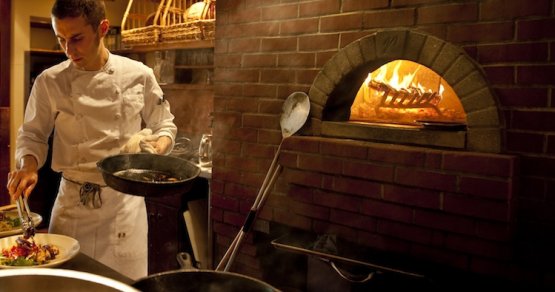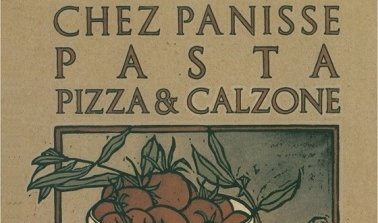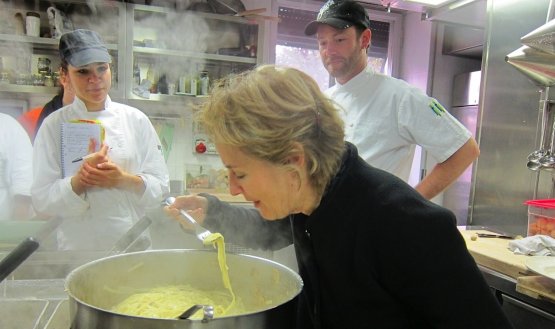This story starts a few months ago when we published an article in which we playfully tried to list and map the styles of pizza that have appeared in the US in the recent past. On that occasion, during our research, we found out that Alice Waters, already unanimously considered a pioneer, if not the creator of California cuisine, had been one of the very first to want a wood oven in her restaurant, the notorious Chez Panisse in Berkeley.
The news intrigued us. We thus tried to contact the great American chef – we still call her like chef, even though she left the kitchen now many years ago, focusing on the management of the restaurant, her books and her many projects, often dedicated to the food education of the younger generations. You need a little patience to reach such a busy person, but we finally managed to speak with her on the phone, a long and fun conversation we’re publishing in two episodes. We dedicate the first, of course, to the initial input that led us to call her. Alice Waters and pizza: how was this love born?
«In the late Seventies I was Italy with a group of friends. We were travelling to Switzerland and stopped in Torino. Suddenly we noticed the fire in the wood oven of a small restaurant: we went inside and had a pizza. It was unforgettable. I had never seen pizza made that way, from the oven and straight to your table. I immediately thought I wanted the same at Chez Panisse too».

The wood oven at Chez Panisse
I wanted to recreate that magic atmosphere in my dining room. As soon as I was back in the States, I started to work at a “Café” area on the top floor of
Chez Panisse. It was between 1978 and 1979. I wanted to respect the Mediterranean inspiration of the restaurant: so while the main influence in the restaurant on the ground floor was French, I wanted an Italian one for the Café on the first floor.
Has your interpretation of pizza evolved over the years?
I never wanted to have a pizzeria. I always thought pizza was the ideal start to a meal, something hot and delicious to share among guests. Initially we served mostly Italian classic pizza,
Margherita, with tomato, mozzarella and basil. Then we tried with a
Calzone, filled with goat cheese, mozzarella and diced prosciutto: the success was extraordinary, almost too big. Nobody wanted to have anything else! Since then we started to experiment with many different ingredients. Even now that we no longer have the
Calzone in the menu, we use the same ingredients for a pizza. At
Chez Panisse we’ve been serving pizza for 35 years nonstop.

Alice Waters published a cook book (also) dedicated to pizza
Never, not at all. And I believe it’s also a matter of fire, of the marvellous and unmistakable aroma that fills the dining room. We even have a large wood grill on both floors at
Chez Panisse: I believe oven and grill give great magic to our dining rooms. They touch people in an almost subliminal way. It’s as if these fires increased your appetite, your desire for something good.
The influences you got from Italian gastronomy go beyond pizza however...
Of course, there are very many. I’ve always been impressed by the extraordinary biodiversity offered by Italy, which is luckily quite preserved. I always think that we have excellent tomatoes here in California, but then whenever I visit southern Italy I taste incredible tomatoes. I’ve always admired your attention to safeguard varieties and seeds, led by gastronomic reasons. This is not a popular choice in the United States. We’re much more focused on quantity than quality. In Italy, instead, this has always been the case, be it grapes, olives, rice or many other vegetables. One of my latest discoveries has been the many varieties of wheat that have been cultivated in Italy for centuries. This discovery led me to study ancient cookbooks from the Roman Empire.

Alice Waters in the kitchen at the American Academy in Rome
The
Academy is an institution dedicated to American artists and students in Rome. Thanks to a scholarship they take residence here. I’m very proud of this project, called
Rome Sustainable Food Project. Through this we’ve completely changed the food inside the
Academy. I believe this could be an example for many other educational organisations. We chose to explore the culinary traditions of Rome and Lazio. It was an extraordinary cooking school for all of us who worked there, together with interns coming from all around the world. We even wrote cookbooks. All the ingredients we use are organic and come from directly from local farmers. It would be nice if
Identità Golose would cover this project in detail [and we will!].
1- to be continued